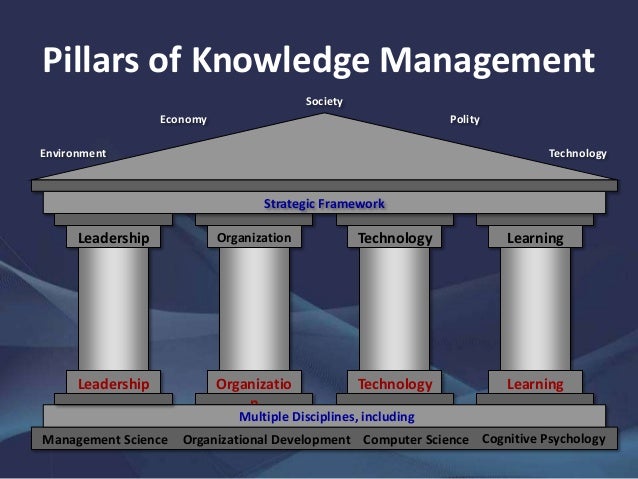
Here’s is a brief summary of the four pillars as they apply to the reality of KM implementation:
- Leadership
Leadership develops business and operational strategies to survive and position for success in today’s dynamic environment. Those strategies determine vision, and must align knowledge management with business tactics to drive the value of KM throughout the enterprise. Focus must be placed on building executive support and KM champions. A successful implementation of a knowledge management system requires a champion or leader at or near the top of an organization who can provide the strong and dedicated leadership needed for cultural change.
- Organization
The value of knowledge creation and collaboration should be intertwined throughout an enterprise. operational processes must align with the KM framework and strategy, including all performance metrics and objectives. while operational needs dictate organizational alignment, a KM system must be designed to facilitate KM throughout the organization. Operational processes must be aligned with the new vision while redesigning the organization and identifying key levers of change, including roles and responsibilities. Introducing knowledge management requires organizational change, and KM inevitably acts as a catalyst to transform the organization’s culture. The increasing value placed on highly capable people, rising job complexity and the universal availability of information on the Internet are fundamental changes contributing to the move by organizations to leverage KM solutions. In order to begin changing the organization, knowledge management must be integrated into business processes.
- Technology
Technology enables and provides all of the infrastructure and tools to support KM within an enterprise. While cultural and organizational changes are vital to achieving a KM strategy, a lack of the proper tools and technology infrastructure can lead to failure. Any technical solution must add value to the process and achieve measurable improvements. Properly assessing and defining IT capabilities is essential, as is identifying and deploying best-of breed KM software and IT tools to match and align with the organization’s requirements. The Gartner Group defines 10technologies that collectively make up full-function KM. The functional requirements that enterprises can select and use to build a KM solution include:
• capture and store,;• search and retrieve,;• send critical information to individuals or groups,;• structure and navigate,;• share and collaborate,;• synthesize,;• profile and personalize,;• solve or recommend,;• integrate with business applications, and;• maintenance.; No technology product meets every requirement, and before selecting a solution, enterprises need to clearly define their KM strategy, scope and requirements, and perform product evaluations to identify technology products that effectively meet their needs.
- Learning
The best tools and processes alone will not achieve a KM strategy. Ultimately, people are responsible for using the tools and performing the operations. Creating organizational behavior that supports a KM strategy will continue long after the system is established. Organizational learning must be addressed with approaches such as increasing internal communications, promoting cross-functional teams and creating a learning community. Learning is an integral part of knowledge management. In this context, learning can be described as the acquisition of knowledge or a skill through study, experience or instruction. Enterprises must recognize that people operate and communicate through learning that includes the social processes of collaborating, sharing knowledge and building on each other’s ideas. Managers must recognize that knowledge resides in people, and knowledge creation occurs in the process of social interaction and learning. It is evident that the need for knowledge management translates throughout the entire enterprise. It is not a separate function characterized by a separate KM department or a KM process; it must be embedded into all of the organization's business processes. Knowledge management is crucial to achieving permanent performance improvements and innovation. Efficient knowledge-intensive core processes and a fundamental architecture must be established to effectively initiate and implement KM. The four pillars clearly provide that necessary architecture.
posted by
vivek rajput
posted by
vivek rajput
No comments:
Post a Comment